1987 SUZUKI GRAND VITARA ECU
[x] Cancel search: ECUPage 141 of 962
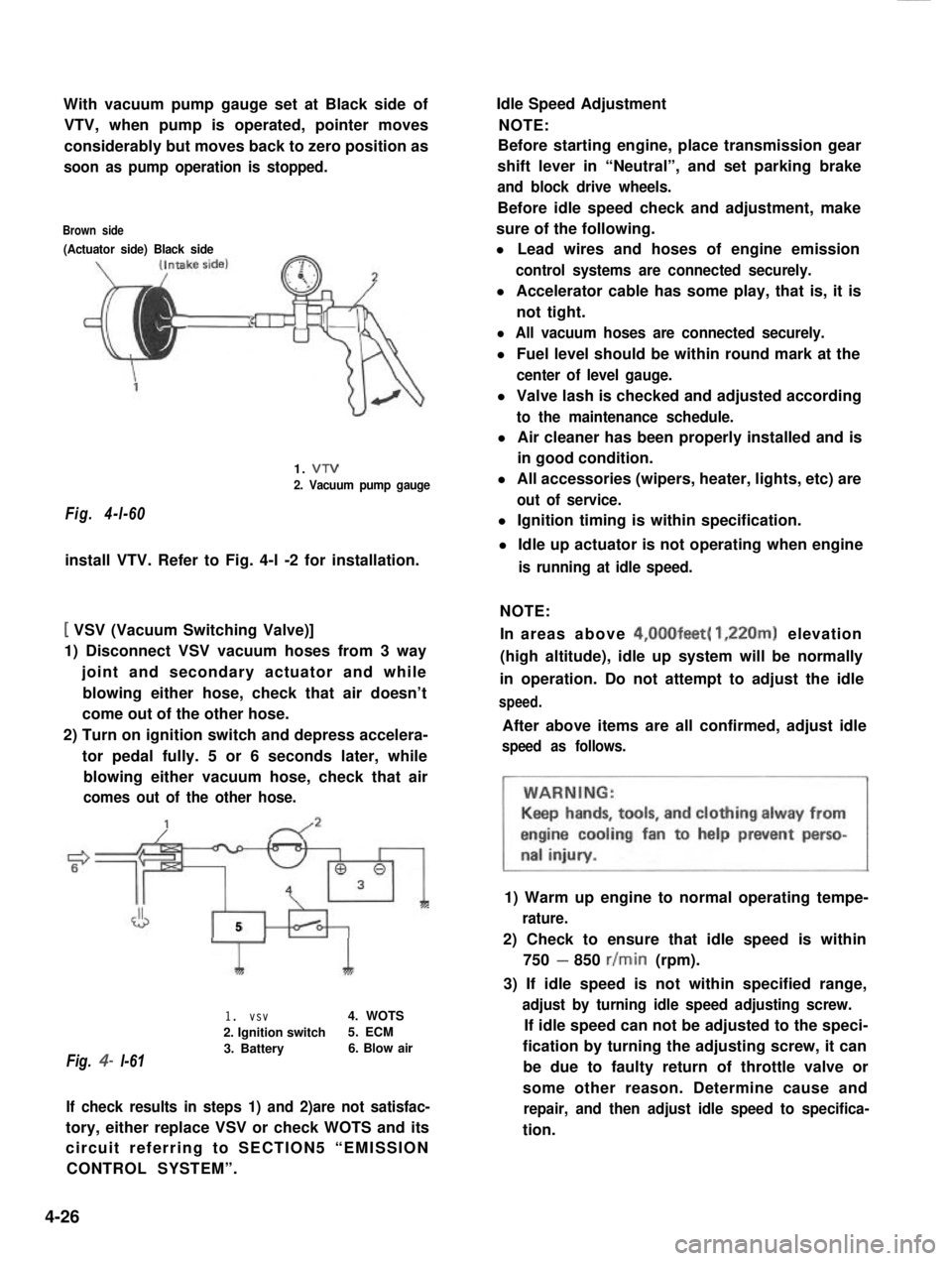
With vacuum pump gauge set at Black side of
VTV, when pump is operated, pointer moves
considerably but moves back to zero position as
soon as pump operation is stopped.
Brown side
(Actuator side) Black side
Fig. 4-l-60
1. VTV
2. Vacuum pump gauge
install VTV. Refer to Fig. 4-l -2 for installation.
[ VSV (Vacuum Switching Valve)]
1) Disconnect VSV vacuum hoses from 3 way
joint and secondary actuator and while
blowing either hose, check that air doesn’t
come out of the other hose.
2) Turn on ignition switch and depress accelera-
tor pedal fully. 5 or 6 seconds later, while
blowing either vacuum hose, check that air
comes out of the other hose.
J5
Fig. 4- l-61
1I
1. vsv4. WOTS
2. Ignition switch5. ECM
3. Battery6. Blow air
If check results in steps 1) and 2)are not satisfac-
tory, either replace VSV or check WOTS and its
circuit referring to SECTION5 “EMISSION
CONTROL SYSTEM”.
Idle Speed Adjustment
NOTE:
Before starting engine, place transmission gear
shift lever in “Neutral”, and set parking brake
and block drive wheels.
Before idle speed check and adjustment, make
sure of the following.
l Lead wires and hoses of engine emission
control systems are connected securely.
l Accelerator cable has some play, that is, it is
not tight.
l All vacuum hoses are connected securely.
l Fuel level should be within round mark at the
center of level gauge.
l Valve lash is checked and adjusted according
to the maintenance schedule.
l Air cleaner has been properly installed and is
in good condition.
l All accessories (wipers, heater, lights, etc) are
out of service.
l Ignition timing is within specification.
l Idle up actuator is not operating when engine
is running at idle speed.
NOTE:
In areas above 4,00Ofeet( 1,220m) elevation
(high altitude), idle up system will be normally
in operation. Do not attempt to adjust the idle
speed.
After above items are all confirmed, adjust idle
speed as follows.
1) Warm up engine to normal operating tempe-
rature.
2) Check to ensure that idle speed is within
750 - 850 r/min (rpm).
3) If idle speed is not within specified range,
adjust by turning idle speed adjusting screw.
If idle speed can not be adjusted to the speci-
fication by turning the adjusting screw, it can
be due to faulty return of throttle valve or
some other reason. Determine cause and
repair, and then adjust idle speed to specifica-
tion.
4-26
Page 145 of 962
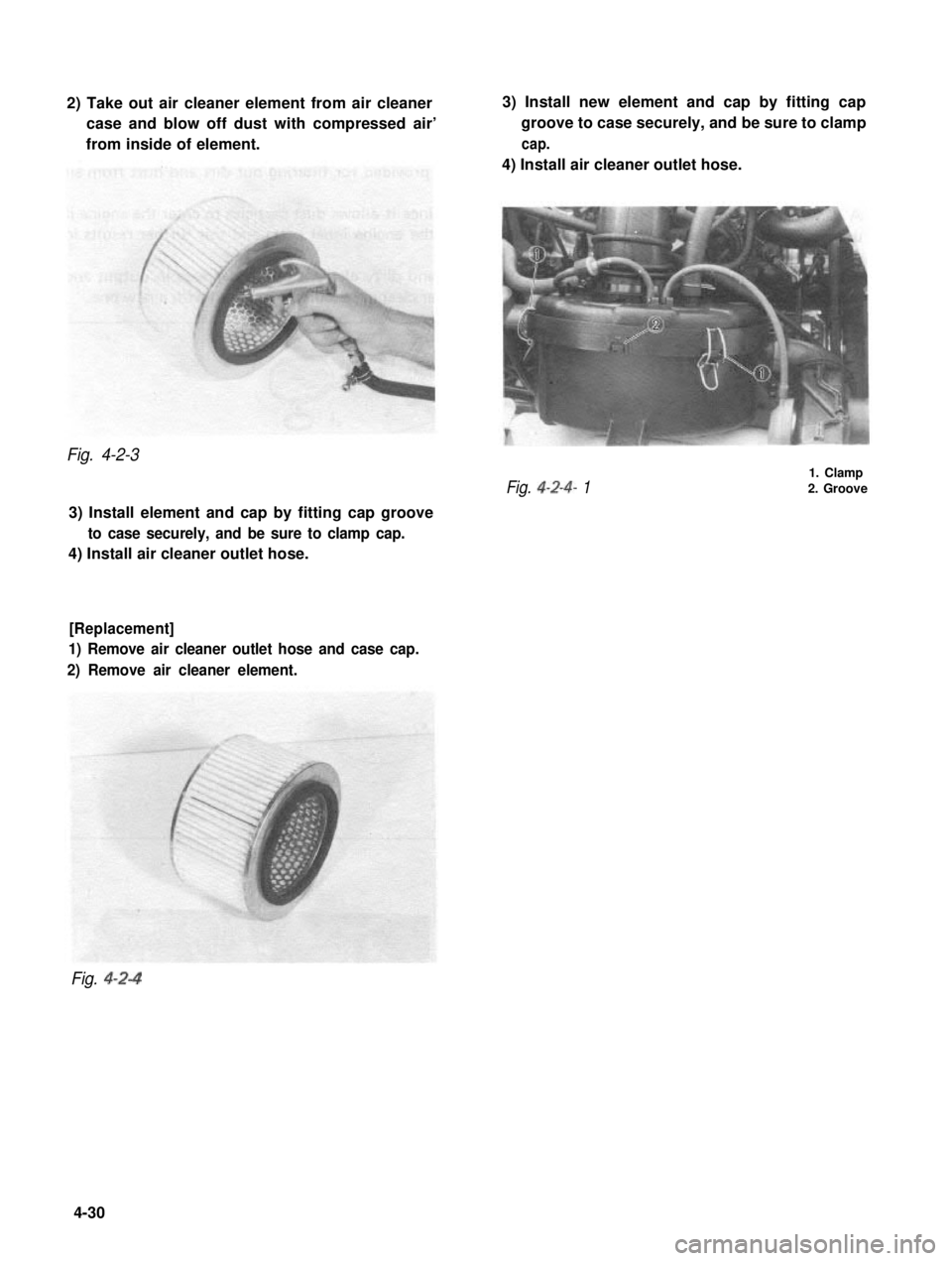
2) Take out air cleaner element from air cleaner
case and blow off dust with compressed air’
from inside of element.
3) Install new element and cap by fitting cap
groove to case securely, and be sure to clamp
cap.
4) Install air cleaner outlet hose.
Fig. 4-2-3
Fig. 4-2-4- 1
1. Clamp2. Groove
3) Install element and cap by fitting cap groove
to case securely, and be sure to clamp cap.
4) Install air cleaner outlet hose.
[Replacement]
1) Remove air cleaner outlet hose and case cap.
2) Remove air cleaner element.
Fig. 4-2-4
4-30
Page 148 of 962
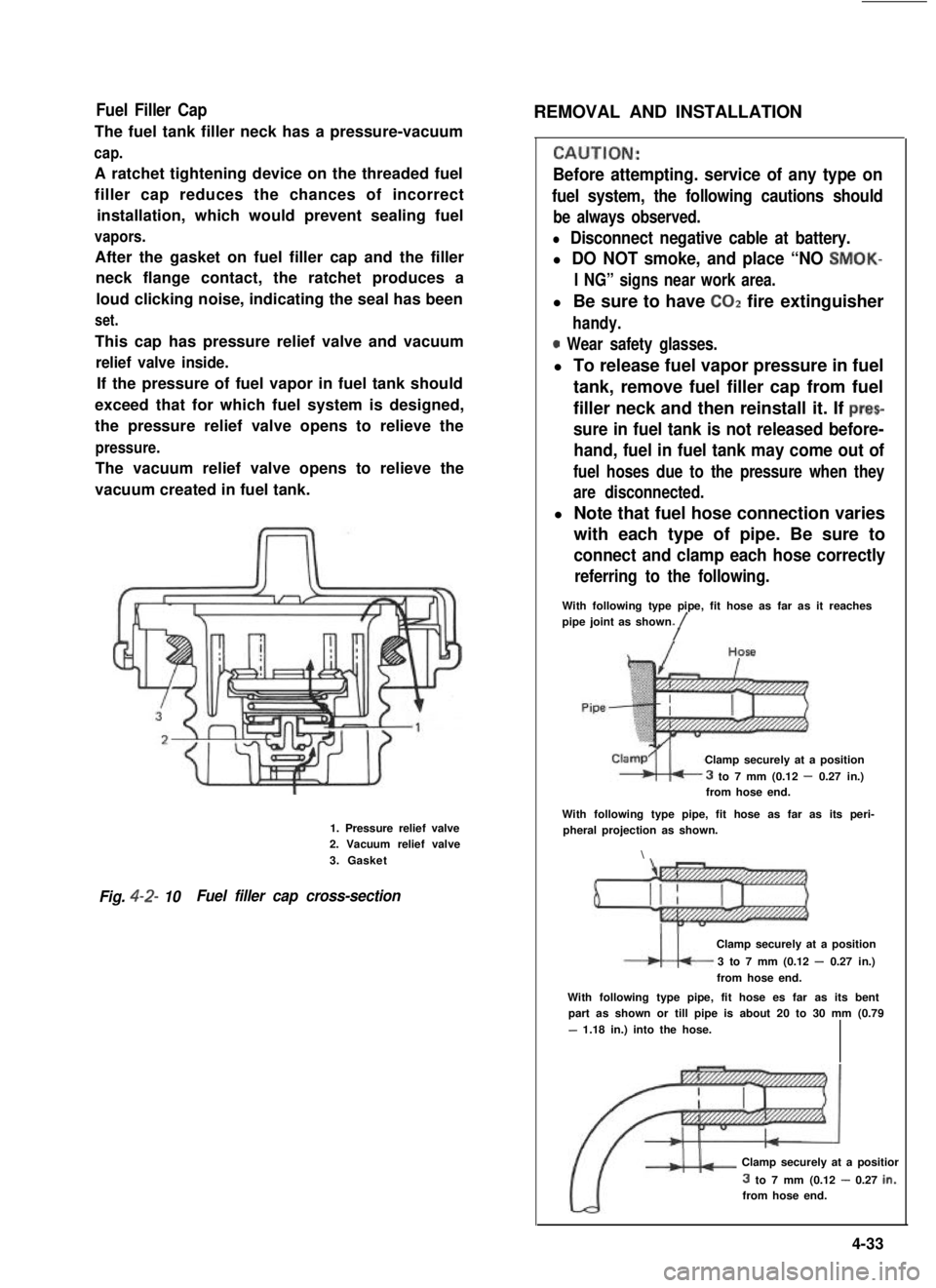
Fuel Filler Cap
The fuel tank filler neck has a pressure-vacuum
cap.
A ratchet tightening device on the threaded fuel
filler cap reduces the chances of incorrect
installation, which would prevent sealing fuel
vapors.
After the gasket on fuel filler cap and the filler
neck flange contact, the ratchet produces a
loud clicking noise, indicating the seal has been
set.
This cap has pressure relief valve and vacuum
relief valve inside.
If the pressure of fuel vapor in fuel tank should
exceed that for which fuel system is designed,
the pressure relief valve opens to relieve the
pressure.
The vacuum relief valve opens to relieve the
vacuum created in fuel tank.
1. Pressure relief valve2. Vacuum relief valve
3. Gasket
Fig. 4-2- 10Fuel filler cap cross-section
REMOVAL AND INSTALLATION
CALJTION:
Before attempting. service of any type on
fuel system, the following cautions should
be always observed.
l Disconnect negative cable at battery.
l DO NOT smoke, and place “NO SMOK-
I NG” signs near work area.
l Be sure to have COZ fire extinguisher
handy.
0 Wear safety glasses.
l To release fuel vapor pressure in fuel
tank, remove fuel filler cap from fuel
filler neck and then reinstall it. If prec
sure in fuel tank is not released before-
hand, fuel in fuel tank may come out of
fuel hoses due to the pressure when they
are disconnected.
l Note that fuel hose connection varies
with each type of pipe. Be sure to
connect and clamp each hose correctly
referring to the following.
With following type pipe, fit hose as far as it reachespipe joint as shown./
Clamp securely at a position
3 to 7 mm (0.12 - 0.27 in.)from hose end.
With following type pipe, fit hose as far as its peri-pheral projection as shown.
\
Clamp securely at a position
3 to 7 mm (0.12 - 0.27 in.)
from hose end.
With following type pipe, fit hose es far as its bentpart as shown or till pipe is about 20 to 30 mm (0.79
- 1.18 in.) into the hose.
Clamp securely at a positior
3 to 7 mm (0.12 - 0.27 in.:from hose end.
4-33
Page 150 of 962
![SUZUKI GRAND VITARA 1987 Service Repair Manual [Fuel tank purging procedure]
WARNING:
This purging procedure will NOT remove
all fuel vapor. Do not attempt any repair
on tank where heat or flame is required, as
an explosion resulting in personal i SUZUKI GRAND VITARA 1987 Service Repair Manual [Fuel tank purging procedure]
WARNING:
This purging procedure will NOT remove
all fuel vapor. Do not attempt any repair
on tank where heat or flame is required, as
an explosion resulting in personal i](/manual-img/20/57437/w960_57437-149.png)
[Fuel tank purging procedure]
WARNING:
This purging procedure will NOT remove
all fuel vapor. Do not attempt any repair
on tank where heat or flame is required, as
an explosion resulting in personal injury
cou Id occur.J
The following procedure is used for purging the
fuel tank.
1) After removing fuel tank, remove all hoses,
fuel level gauge from fuel tank.
2) Drain all remaining fuel from tank.
3) Move tank to flushing area.
4) Fill tank with warm water or tap water, and
agitate vigorously and drain. Repeat this
washing until inside of tank is clean.
Replace tank if inside is rusty.
5) Completely flush out remaining water after
washing.
[ Installation]
Reverse removal procedure for installation using
care for the following.
Tightening torque30-45 Nm
for fuel tank(3.0- 4.5 kg-m)
drain plug(22.0 - 32.5 lb-ft)
Refer to Fig. 4-2-5 for piping and clamp posi-
tions.
l Make sure for correct hose-to-pipe connec-
tion.
l Clamp hoses securely.
l Upon completion of installation, start engine
and check hose joints for leaks.
MAINTENANCE SERVICES
Fuel Lines
Visually inspect fuel lines and connections for
evidence of fuel leakage, hose cracking, and
damage. Make sure all clamps are secure.
Repair leaky joints, if any.
Replace hoses that are suspected of being crack-
ed.
Fig. 4-2-14
Fuel Filler (tank) Cap
Visually inspect gasket of fuel filler cap.
If it is damaged or deteriorated, replace filler cap
with new one.
NOTE:
If cap requires replacement, only a cap with
the same features should be used. Failure to
use correct cap can result in a serious malfunc-
tion of the system.
Fig. 4-2-15
1. Fuel filler cap
2. Fuel filler capgasket
Fuel Filter
As said before, this filter does not permit dis-
assembly: it is to be replaced with a new one
periodically.
Replace fuel filter referring to previous item of
“Fuel Filter Removal and Installation”.
This servicing must be performed in a well
ventilated area and away from any open
flames (such as gas hot water heaters).
4-35
Page 151 of 962

4-4. ACCELERATOR PEDAL
PRECAUTIONS TO BE TAKEN IN ACCELERATOR PEDAL INSTALLATION
“A’,
-w/i
Apply grease to accelerator
cable hook hole of pedal.
Install accelerator pedal
return spring securely as
shown in figure.
Fig. 4-2- 16
Adjustment of full open position
(1)Loosen lock nut and tighten bolt slightly.
(2)Depress Dedal as far as throttle valve opensf&
(3)In this state. bring bolt into contact with
pedal by turning bolt and then loosen boltby 2 tums.
(4) Tighten lock nut there securely.
4-36
Page 169 of 962
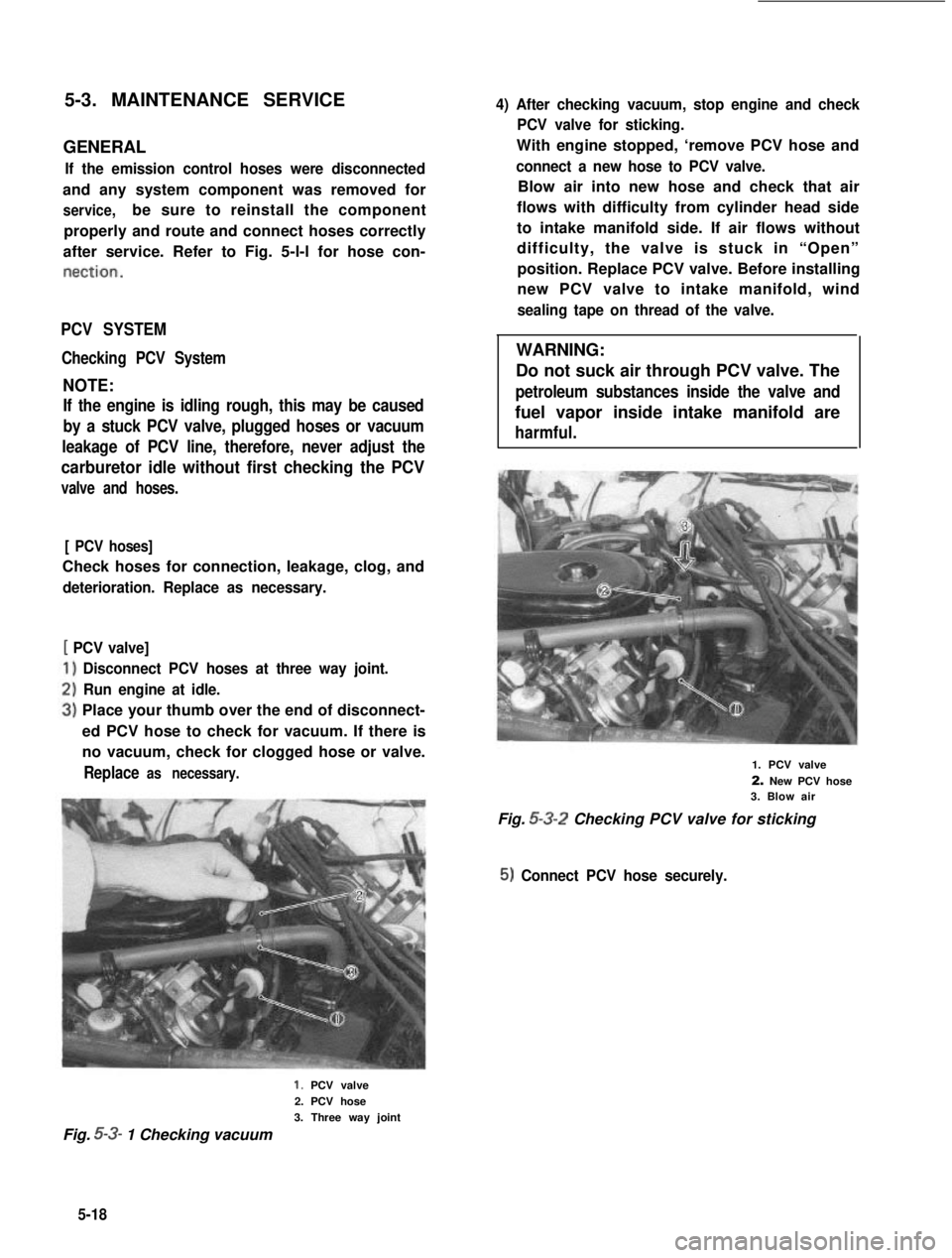
5-3. MAINTENANCE SERVICE
GENERAL
If the emission control hoses were disconnected
and any system component was removed for
service,be sure to reinstall the component
properly and route and connect hoses correctly
after service. Refer to Fig. 5-l-l for hose con-
nection.
PCV SYSTEM
Checking PCV System
NOTE:
If the engine is idling rough, this may be caused
by a stuck PCV valve, plugged hoses or vacuum
leakage of PCV line, therefore, never adjust the
carburetor idle without first checking the PCV
valve and hoses.
[ PCV hoses]
Check hoses for connection, leakage, clog, and
deterioration. Replace as necessary.
[ PCV valve]
Disconnect PCV hoses at three way joint.
Run engine at idle.
Place your thumb over the end of disconnect-
ed PCV hose to check for vacuum. If there is
no vacuum, check for clogged hose or valve.
Replace as necessary.
4) After checking vacuum, stop engine and check
PCV valve for sticking.
With engine stopped, ‘remove PCV hose and
connect a new hose to PCV valve.
Blow air into new hose and check that air
flows with difficulty from cylinder head side
to intake manifold side. If air flows without
difficulty, the valve is stuck in “Open”
position. Replace PCV valve. Before installing
new PCV valve to intake manifold, wind
sealing tape on thread of the valve.
WARNING:
Do not suck air through PCV valve. The
petroleum substances inside the valve and
fuel vapor inside intake manifold are
harmful.
1. PCV valve
2. New PCV hose3. Blow air
Fig. 5-3-2 Checking PCV valve for sticking
5) Connect PCV hose securely.
1. PCV valve
2. PCV hose
3. Three way joint
Fig. 5-3- 1 Checking vacuum
5-18
Page 172 of 962
![SUZUKI GRAND VITARA 1987 Service Repair Manual [Hoses]
Visually inspect hoses and pipe for cracks,
damage, or excessive bends, and hose connec-
tion for tightness.
Fig. 5-3-9
HOT IDLE COMPENSATOR (HIC)
Checking Hot Idle Compensator
1) Remove air i SUZUKI GRAND VITARA 1987 Service Repair Manual [Hoses]
Visually inspect hoses and pipe for cracks,
damage, or excessive bends, and hose connec-
tion for tightness.
Fig. 5-3-9
HOT IDLE COMPENSATOR (HIC)
Checking Hot Idle Compensator
1) Remove air i](/manual-img/20/57437/w960_57437-171.png)
[Hoses]
Visually inspect hoses and pipe for cracks,
damage, or excessive bends, and hose connec-
tion for tightness.
Fig. 5-3-9
HOT IDLE COMPENSATOR (HIC)
Checking Hot Idle Compensator
1) Remove air intake case with hose.
2) Check temperature around HIC with thermo-
meter.
3) If temperature is below 45°C (113” F), air
should not come out of HIC when air is
blown into hose. If temperature is above
65°C (149” F), air comes out of HIC.
Replace H IC if defective.
4) After checking, install air intake case and
connect hose to intake manifold.
NOTE:
l To check HIC for operation at higher than
65°C (149°F) temperature when HIC (bi-
metal) temperature is lower than 45°C
(113”F), warm it up with hair drier or photo
light before checking.
l Never touch bimetal or valve in HIC.
1
Below 45°C (113’F)Above 65’C (149’F)
Fig.5-i- 10
DECELERATION MIXTURE CONTROL
SYSTEM
Checking
[Hoses]
Inspect each hose for pinholes, cracks or damage.
Also check to ensure that each joint is securely
connected. Any part found defective must be
corrected or replaced.
.
Fig. 5-3- 11
[Mixture control valve (MCV)]
1) Warm up the engine to normal operating
temperature.
2) Disconnect hose @ and reconnect it. At this
time, check that air is drawn into MCV.
NOTE:
At this time, the engine will idle rough or die,
but this is normal.
A piece of paper
If the above checks show anything wrong,
replace it.
5-21
Page 177 of 962
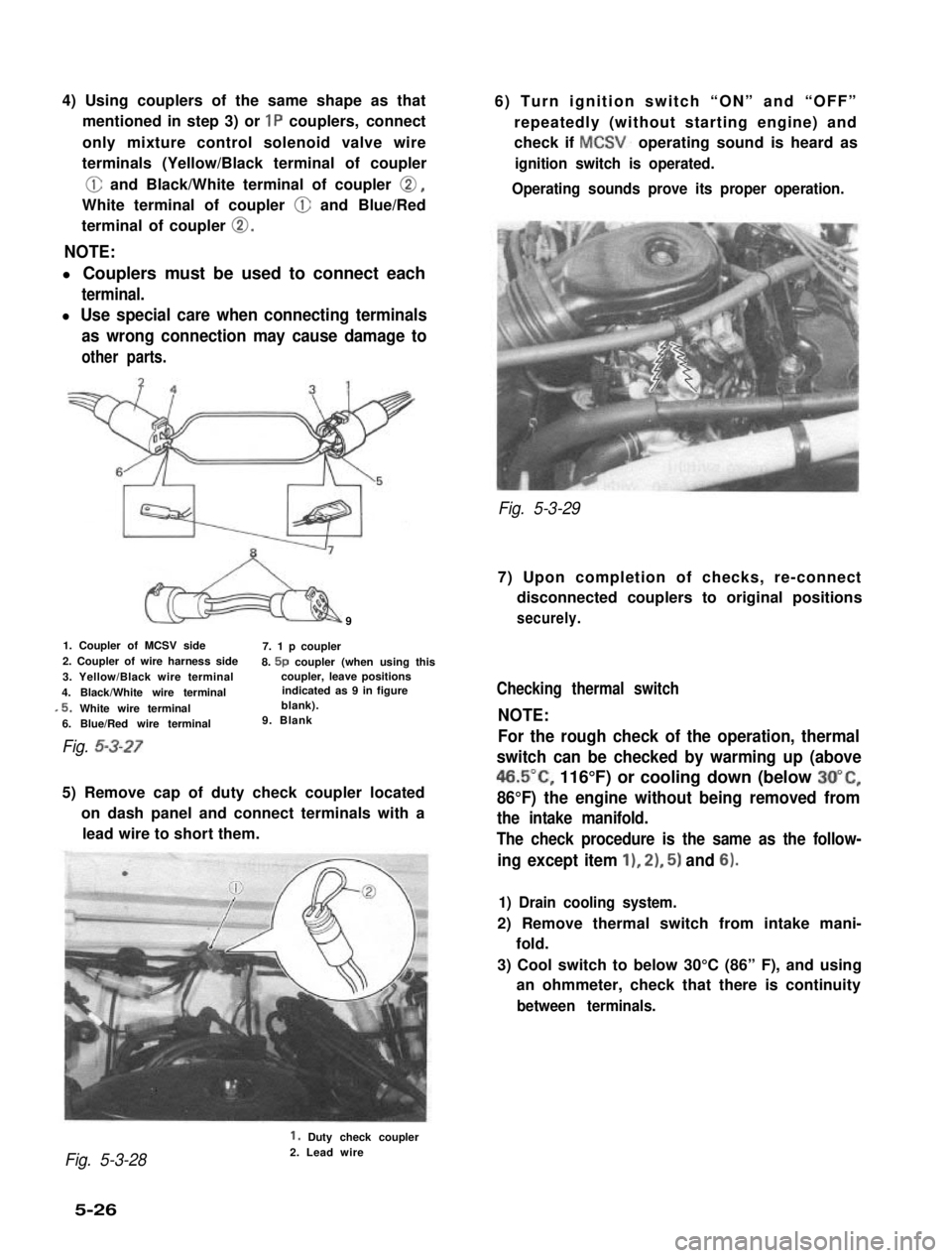
4) Using couplers of the same shape as that
mentioned in step 3) or 1P couplers, connect
only mixture control solenoid valve wire
terminals (Yellow/Black terminal of coupler
@ and Black/White terminal of coupler 0,
White terminal of coupler @ and Blue/Red
terminal of coupler 0.
NOTE:
l Couplers must be used to connect each
terminal.
l Use special care when connecting terminals
as wrong connection may cause damage to
other parts.
9
1. Coupler of MCSV side7. 1 p coupler2. Coupler of wire harness side8. 5p coupler (when using this3. Yellow/Black wire terminalcoupler, leave positions
4. Black/White wire terminalindicated as 9 in figure
,5. White wire terminalblank).
6. Blue/Red wire terminal9. Blank
Fig. 5-3-27
5) Remove cap of duty check coupler located
on dash panel and connect terminals with a
lead wire to short them.
6) Turn ignition switch “ON” and “OFF”
repeatedly (without starting engine) and
check if MCSV. operating sound is heard as
ignition switch is operated.
Operating sounds prove its proper operation.
Fig. 5-3-29
7) Upon completion of checks, re-connect
disconnected couplers to original positions
securely.
Checking thermal switch
NOTE:
For the rough check of the operation, thermal
switch can be checked by warming up (above
46.5”C, 116°F) or cooling down (below 3O”C,
86°F) the engine without being removed from
the intake manifold.
The check procedure is the same as the follow-
ing except item 11, 21, 5) and 6).
1) Drain cooling system.
2) Remove thermal switch from intake mani-
fold.
3) Cool switch to below 30°C (86” F), and using
an ohmmeter, check that there is continuity
between terminals.
Fig. 5-3-28
1. Duty check coupler2. Lead wire
5-26